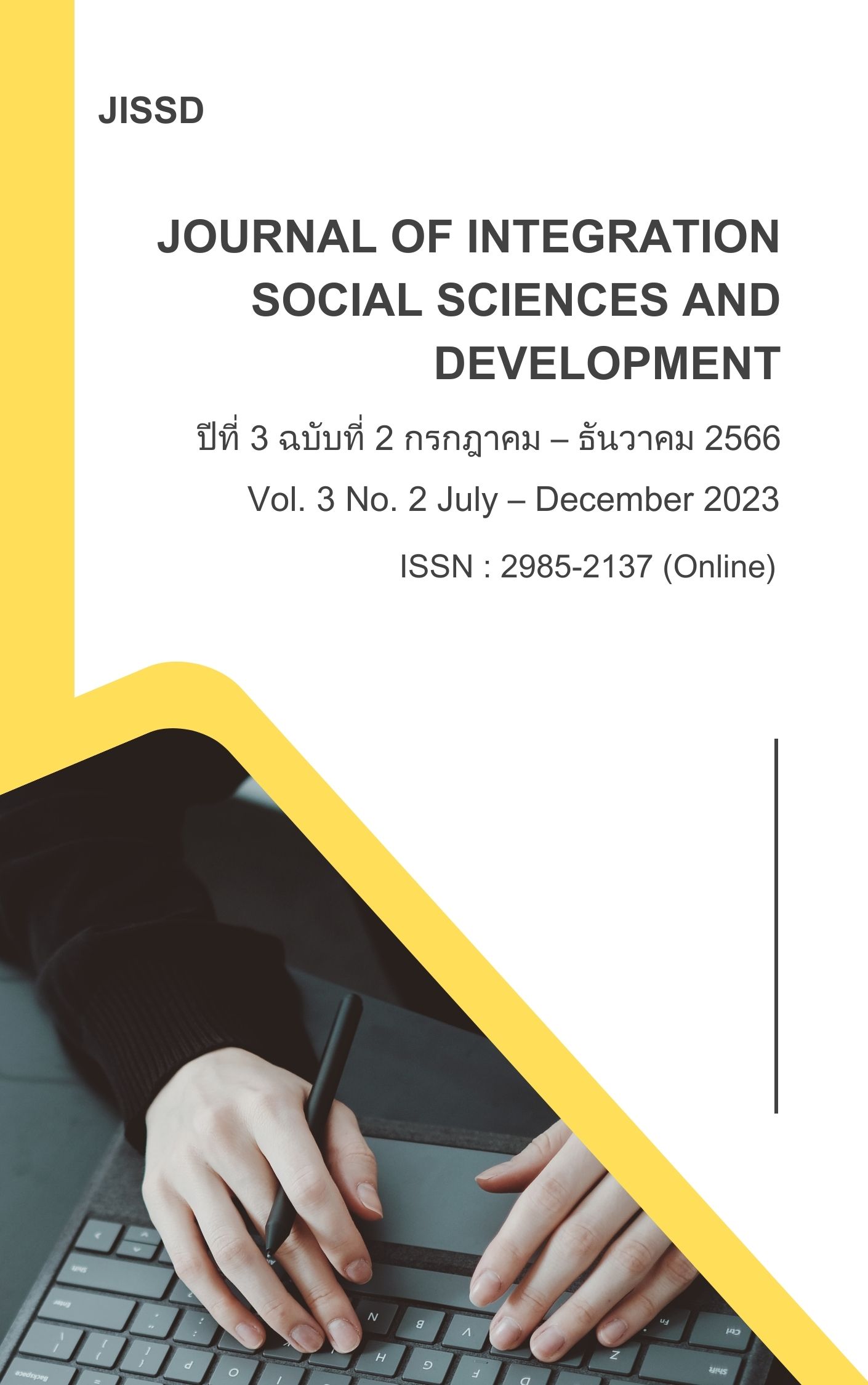Development of the curriculum and process for teaching local history The story of Luang Pu Chuen Khemajaro of Wangwareewonratwattana School Under Nakhon Ratchasima Primary Educational Service Area Office 3
Main Article Content
Abstract
The objectives of this research are 1) to develop the curriculum and teaching process for local history on Luang Pu Chuen Khemjaro of Wangwaree Wanaratwattana School, 2) to study the learning results from learning according to the local history curriculum on Luang Pu Chuen Khemjaro of Wangwaree Wanaratwattana School. Using the criterion of 80 percent, and 3) to study satisfaction with the curriculum and process of local history on Luang Pu Chuen Khemjaro through the teaching process. of Wangwareewanratwattana School, the population used in the research included kindergarten students. 2-6th grade, 76 people. The research instrument was an evaluation of the appropriateness of the curriculum and teaching process. and satisfaction questionnaire Statistics used in data analysis include percentage, mean, and standard deviation. The results of the study found that 1) the curriculum and process of teaching local history Regarding Luang Pu Chuen Khemajaro of Wang Wawaree Wanarat Wattana School, the results of the overall suitability evaluation were at the highest level. with an overall average of 4.65, the local history curriculum consists of leadership, vision, principles, objectives, curriculum structure, learning content, course descriptions, learning management guidelines, media/learning resources, and measurement and evaluate. As for the process of teaching local history, there are 4 steps: (1) stimulating interest (E: Engagement) (2) organizing 5-step activities for teaching history (A: Activity) (3) reflecting on the results (R: Reflection) and (4) Evaluation (A: Assessing). 2) Learning outcomes according to the local history curriculum and process the story of Luang Pu Chuen Khemjaro of Wangwaree Wanaratwattana School found that students had average scores in all 3 areas after studying above the criteria of 80 percent in the area of knowledge, the average score was 85.29 percent, Skills in working has an average score of 89.51 percent, and desirable characteristics Has an average score of 94.23 percent. And 3) students are satisfied with the local history curriculum the story of Luang Pu Chuen Khemjaro of Wangwaree Wanaratwattana School. highest level.
Article Details
References
กระทรวงศึกษาธิการ. (2566). ประกาศกระทรวงศึกษาธิการ เรื่อง นโยบายและจุดเน้นของกระทรวงศึกษาธิการ ประจำปีงบประมาณ พ.ศ. 2567. สืบค้นจาก https://moe360.blog/2023/01/04/policy-and-focus-moe-fiscal-year-2024/.
จริยา ศรีเพชร. (2550) การพัฒนาหลักสูตรสถานศึกษาเรื่องคลองมหาสวัสดิ์ สำหรับนักเรียนชั้นประถมศึกษาปีที่ 6. (ศึกษาศาสตรมหาบัณฑิต, มหาวิทยาลัยศิลปากร).
ทีฆกุล คำงาม. (2560). ผลของการจัดการเรียนรู้ประวัติศาสตร์ท้องถิ่นโดยใช้กระบวนการเรียนการสอน DACIR ที่มีต่อการเรียนรู้มโนทัศน์ทางประวัติศาสตร์ของนักเรียนประถมศึกษาปีที่ 5. (ศึกษาศาสตรมหาบัณฑิต, มหาวิทยาลัยศิลปากร).
นิธิ เอียวศรีวงศ์. (2548). การใช้แนวคิดเรื่องศูนย์กลางและเครือข่ายในการศึกษาประวัติศาสตร์ท้องถิ่น. กรุงเทพฯ: สถาบันทักษินคดีศึกษา.
บุญชม ศรีสะอาด. (2553). การวิจัยเบื้องต้น. (พิมพ์ครั้งที่ 8). กรุงเทพฯ: สุวีริยาสาส์น.
บุญเรียง ขจรศิลป์. (2543). วิธีวิจัยทางการศึกษา. (พิมพ์ครั้งที่ 5). กรุงเทพฯ: พี.เอ็น.การพิมพ์.
ปัณฑิตา ไชยโย และณัฐเชษฐ์ พูลเจริญ. (2566). การจัดกิจกรรมการเรียนรู้ประวัติศาสตร์ท้องถิ่นเมืองน่าน โดยใช้ชุมชนเป็นฐาน เพื่อส่งเสริมกระบวนการคิดอย่างมีวิจารณญาณ. วารสารปัญญา, 30(1), 37-48.
พรทิพย์ หุ่นสะดี. (2553). การพัฒนาหลักสูตรท้องถิ่นหน่วยการเรียนรู้อำเภอสัตหีบ สำหรับนักเรียนชั้นประถมศึกษาปีที่ 5. (ศึกษาศาสตรมหาบัณฑิต, มหาวิทยาลัยบูรพา).
พัชรี ม้าลออเพชร. (2558). การพัฒนาหลักสูตรรายวิชาประวัติศาสตร์ เรื่อง ประวัติศาสตร์เมืองกาญจนบุรี สำหรับนักเรียนชั้นประถมศึกษาปีที่ 6. (ศึกษาศาสตรมหาบัณฑิต, มหาวิทยาลัยศิลปากร).
มยุรี วีระประเสริฐ. (2558). สมเด็จพระเทพรัตนราชสุดาฯ สยามบรมราชกุมารีกับการศึกษา ประวัติศาสตร์และโบราณคดี. กรุงเทพฯ: จุฬาลงกรณ์มหาวิทยาลัย.
รุ่งอรุณ หัสชู. (2553). การพัฒนาหลักสูตรท้องถิ่นรายวิชาเพิ่มเติม ท16201 นิทานพื้นบ้าน สำหรับนักเรียนชั้นประถมศึกษาปีที่ 6 โรงเรียนวัดวังก์วิเวการาม อำเภอสังขละบุรี จังหวัดกาญจนบุรี. (ศึกษาศาสตรมหาบัณฑิต, มหาวิทยาลัยศิลปากร).
ล้วน สายยศ และอังคณา สายยศ. (2538). เทคนิคการวิจัยทางการศึกษา. (พิมพ์ครั้งที่ 4). กรุงเทพฯ: สุวีริยาสาส์น.
วินัย พงศ์ศรีเพียร. (2543). ครูกับการเรียนการสอนประวัติศาสตร์ไทยในคู่มือการจัดกิจกรรมการ เรียนการสอนประวัติศาสตร์ : ประวัติศาสตร์ไทยจะเรียนจะสอนกันอย่างไร. กรุงเทพฯ: โรงพิมพ์การศาสนา กรมการศาสนามหาวิทยาลัยศิลปากร.
สกุลวัฒน์ รัชนีกร, สภณภัทร ศรีแสงยงค์ และสฎายุ ธีระวณิชตระกูล. (2560). การพัฒนาหลักสูตรหน่วยการเรียนรู้เรื่องเมืองพัทยา กล่มุสาระสังคมศึกษา ศาสนาและวัฒนาธรรม สำหรับนักเรียนชั้นประถมศึกษาปีที่ 4. วารสารศึกษาศาสตร์ มหาวิทยาลัยนเรศวร, 19(3), 329-342.
สามารถ สีทอง. (2563). การพัฒนาหลักสูตรท้องถิ่น เรื่อง เมืองโบราณบางพาน รายวิชาประวัติศาสตร์ สำหรับนักเรียนชั้นประถมศึกษาปีที่ 4. (ครุศาสตรมหาบัณฑิต, มหาวิทยาลัยราชภัฏอุตรดิตถ์).
สำนักงานกระทรวงศึกษาธิการ. (2560). หลักสูตรแกนกลางขั้นพื้นฐาน พุทธศักราช 2551. กรุงเทพฯ: สำนักงานกระทรวงศึกษาธิการ.
สุคนธ์ สินธพานนท์. (2553). พัฒนาทักษะการคิดพิชิตการสอน. (พิมพ์ครั้งที่ 4). กรุงเทพฯ: เลี่ยงเชียง.
สุริยนต์ กัลยาณี. (2566). การจัดการเรียนรู้ประวัติศาสตร์ผ่านแหล่งเรียนรู้ทางประวัติศาสตร์ท้องถิ่นจันทบุรี. สืบค้นจาก https://www.chan1.net/oit/2817/chan1.
อมรวิชช์ นาครทรรพ. (2551). การศึกษาในวิถีชุมชน : การสังเคราะห์ประสบการณ์ในชุดโครงการวิจัย ด้านการศึกษากับชุมชน (รายงานการวิจัย). กรุงเทพฯ: สำนักงานกองทุนสนับสนุนการวิจัย (สกว).
อรรถจักร์ สัตยานุรักษ์. (2548). ประวัติศาสตร์เพื่อชุมชน : ทิศทางใหม่ของการศึกษาประวัติศาสตร์ (รายงานการวิจัย).กรุงเทพฯ: สำนักงานกองทุนสนับสนุนการวิจัย (สกว).
Taba, H., & Spalding, W. B. (1962). Curriculum development: Theory and practice (Vol. 37). New York: Harcourt, Brace & World.
Tyler, R.W. (1949). Basic principles of curriculum and instruction. Chicago: University of Chicago Press.


